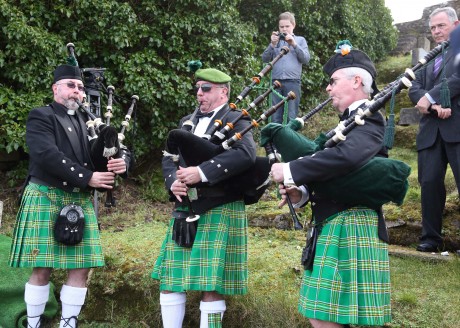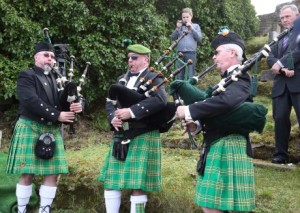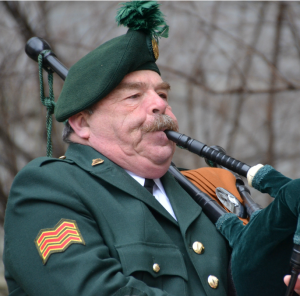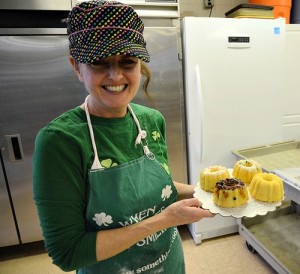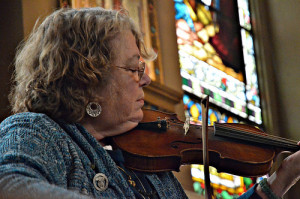This Sunday is Philadelphia’s St. Patrick’s Day parade, the second oldest in the country and one of the best. As veteran parade goers, we highly recommend certain spots on the parade route, which starts at JFK Boulvevard and marches down the Parkway. Anywhere near Tir na Nog is always great—the road is narrow there so you can get up close and personal with the floats, bands, and dancers if you want to get some good photos.
Con Murphy’s Pub on the Parkway is also a great locale—it’s small, so can’t squeeze in lots of onlookers, but if you find a spot you can stay warm while watching the parade with a beer. Kinda like being at home (you can see the parade live starting at 1 PM on CBS3, with Kathy Orr and Chris May), but with a little more atmosphere.
Then there’s the viewing stand down by Eakins Oval parking lot. All the dancers and bands get jiggy in front of the stands, where you can usually find CBS3’s charming traffic guy, Bob Kelly, interviewing folks (you might get interviewed yourself!).
We’ll all be there, so if you see us, come up and say hello! And look for my girls, The Divine Providence Rainbow Irish Dancers, who will be showing off their brand new jackets that they bought with proceeds from their Christmas recital this year. They’re pretty proud of those jackets so let them know how great they look.
BUT, before Sunday comes Saturday and there’s so much going on that your head will spin. In a nice way.
At 2 PM there will be a memorial service at West Laurel Hill Cemetery in Bala Cynwyd where six railroad workers, who died more than 180 years ago, were buried last year. A seventh, John Ruddy, was buried last weekend in Ardara, County Donegal, with members of his family in attendance. Irish Center President Vincent Gallagher donated a spot in his family plot for Ruddy’s burial.
Marita Krivda Poxon will be signing her wonderful new book, Irish Philadelphia, at the Plough and the Stars in Philadelphia on Saturday frm 4 to 5, then from 5:30 to 6:30. It’s a great gift for your favorite Irishman. The book is also available at amazon.com.
The play Jimmy Titanic is still on at the Adrienne Theatre on Sansom Street.
At noon, Galway Guild, a local group, is playing at Marty Magee’s in Prospect Park. They’re heading to Paddy Whacks in Philly at 9 for another Saturday gig.
A couple of other events start in the early afternoon: There’s Beerfest at Harrah’s Philly, which has a tangential link to St. Patrick’s Day in that they’re serving lots of beer (our guess).
Catch the Broken Shillelaghs and Slainte at Dubh Linn Square in Cherry Hill for Paddypalooza, an afternoon delight of music and fundraising for The Claddagh Fund, a charity started by Ken Casey of the Dropkick Murphy’s who are appearing at the Electric Factory on Saturday night.
The great little Conshy parade is next weekend, but on Saturday, they celebrate their grand marshal, Tom Couhglin, at a special ball at the Washington Fire House at Elm and Fayette Streets in Conshohocken.
Mary Courtney and Morning Star—she’s an extraordinary singer, and they’re an extraordinary band—will be performing at 8 PM The Irish Center, 6815 Emlen Street, Philadelphia, a Philadelphia Ceili Group concert.
The John Byrne Band and Friends will be debuting the band’s newest CD, Celtic Folk, at a concert at Sacred Heart Church in Riverton, NJ on Saturday night at 7:30 PM.
Mythica and Melissa Cox will be bringing their amalgam of Irish, Scottish, folk and world music to The Queen on 500 North Market Street in Wilmington, DE. on Saturday night.
There’s also a St. Patrick’s Day Celtic Holiday Concert featuring The Maidens IV, Irish Blessing, the Ladeens, piper Chris Lewis, and The Cara School of Irish Dance at the Schneider Center in Parkesburg, Pa.
On Sunday, start your day off right with Mass at St. Patrick’s Church at 20th and Locust Streets in Philadelphia. Archbishop Charles Chaput is expected to be there, along with many other Philadelphia-area VIPs. There are also post-parade parties all over the city, including at The Irish Center.
McDermott’s Handy will be performing the afternoon at Old Friends Meeting House in Bordentown, NJ.
There’s also a St. Patrick’s Day Celtic Holiday Concert at St. Malachi’s in Cochranville featuring all the folks from the Parkesburg concert listed above.
And at 8 PM, head down to the North Star on Poplar Street in Philly to hear The Tossers, a six-piece Celtic punk band from Chicago, who regularly tour with The Dropkick Murphy’s.
And it’s not even St. Patrick’s Day yet.
On Monday, the Mayo County Council (yes, that Mayo) will be at Maloney’s Pub in Ardmore where you can learn more about Admiral William Brown, an Irish-born Argentine admiral who became Argentina’s greatest naval hero. There’s no charge and there will be bar specials.
Harper Janet Harbison will be performing on Monday night at the Markeim Center for the Arts in Haddonfield, NJ. You can also hear her—and get some pointers—at her workshop on Tuesday night at the Virginia Harp Center in Haddonfield.
On Wednesday, you have your choice: The Irish Rovers on their farewell tour at World Café Live at the Queen in Wilmington, or the amazing accordionist from Galway, Sharon Shannon, at Sellersville.
On Thursday, catch Dervish at Longwood Gardens (and on this little video).
Or you could taste-test some Irish coffee at AOH Notre Dame Div. 1 Hall in Swedesburg, a little event that gets bigger every year, with eight to 10 contestants brewing up their finest creations for the judges (and you get to be one). That runs from 7-9 PM.
Also on Thursday, hear Billy Donahue and Jack McKee of the Shantys at Schileen’s Pub in Westville, NJ. And Galway Guild at the Tap Room in Morton, PA.
On Friday, tune in to CBS3 at 6:30 AM to hear Blackthorn playing us up to St. Patrick’s Day. Later in the evening, the band will be performing at La Costa in Sea Isle, NJ. (Is it summer yet?)
On Friday night, The John Byrne Band, with No Irish Need Apply, will be doing the music of Shane MacGowan and the Pogues at the World Café Live in Philadelphia. They will all have teeth.
Also on Friday night:
Natalie MacMaster, the powerhouse Canadian fiddler, will be at the Annenberg Center for the Performing Arts.
Carbon Leaf, a Celtic band from Virginia that often performs at Bethlehem’s Celtic Classic, will be at World Café Live at the Queen in Wilmington.
The Trenton Titans hockey team is having Irish Night at the Sun National Bank Center in Trenton. Expect both dancing and fighting.
The Galway Guild will be at Con Murphys on the Parkway in Philly starting at 6 PM.
And The Broken Shillelaghs will be at Lazy Lanigan’s Publick House in Sewell, NJ.
A little taste of what’s ahead: St. Patrick’s Day is on Sunday! And on St. Patrick’s eve, look for parades in Bucks County, Conshohocken, and Springfield, Delaware County; Jamison at Paddy Whacks; a St. Patrick’s Day Party at the Knights of Columbus Hall in Glenside with the Molly Maguire’’s Ceilidh Band (expect authentic traditional Irish celebration); and much, much more.
Don’t believe me? Check our calendar.
And keep checking back. New things are being added every day. Um, pretty much every minute.


